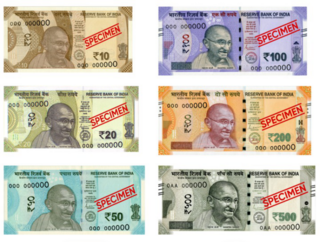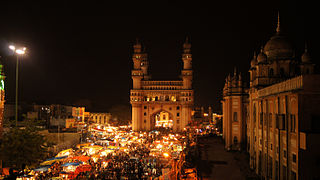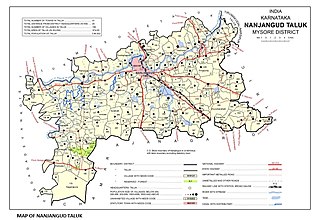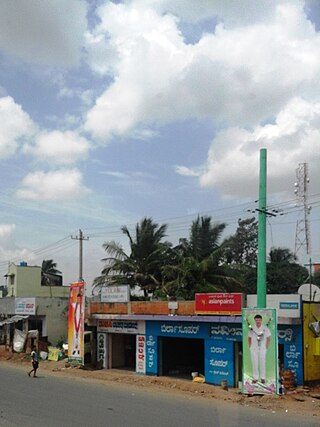Related Research Articles

Tirumala Tirupati Devasthanams (TTD) is an independent trust which manages various temples, including the Tirumala Venkateswara Temple in Andhra Pradesh, India. The trust oversees the operations and finances of the richest and the most visited religious center in the world. It is also involved in various social, religious, literary and educational activities. TTD is headquartered at Tirupati and employs about 16,000 people. Srivani trust was set up by TTD in 2019 to promote Sanātana Dharma by constructing temples in SC-ST-BC habitations, renovating ancient temples, and providing funds under Dhup-Deepa-Naivedyam Scheme to those temples facing financial difficulty. By January 2023, TTD has taken up construction of 2,068 temples in Andhra Pradesh, Telangana, Pondicherry and Karnataka. TTD's main source of income is Srivani darshan tickets which earn Rs 1 crore per day in January 2024.

The Indian rupee is the official currency in India. The rupee is subdivided into 100 paise. The issuance of the currency is controlled by the Reserve Bank of India. The Reserve Bank manages currency in India and derives its role in currency management on the basis of the Reserve Bank of India Act, 1934.

The Charminar is a monument located in Hyderabad, Telangana, India. Constructed in 1591, the landmark is a symbol of Hyderabad and officially incorporated in the emblem of Telangana. The Charminar's long history includes the existence of a mosque on its top floor for more than 425 years. While both historically and religiously significant, it is also known for its popular and busy local markets surrounding the structure, and has become one of the most frequented tourist attractions in Hyderabad. Charminar is also a site of numerous festival celebrations, such as Eid-ul-adha and Eid al-Fitr, as it is adjacent to the city's main mosque, the Makkah Masjid.

Nanjangud, officially known as Nanjanagudu, is a town in the Mysuru district of Indian state of Karnataka. Nanjangud lies on the banks of the river Kapila, 23 km from the city of Mysore. Nanjangud is famous for the Srikanteshwara Temple located here. Nanjangud is also called Dakshina Kashi. This town is also famous for a type of banana grown in the region called the Nanjanagoodu rasabale. Nanjangud's local administrative unit was designated as a Municipal Committee in 2015 by including Devirammanahalli and Kallahalli village.

The Sri Venkateswara Swami Temple is a Hindu temple situated in the hills of Tirumala at Tirupati in Tirupati district of Andhra Pradesh, India. The temple is dedicated to Venkateswara, a form of Vishnu, who is believed to have appeared on the earth to save mankind from trials and troubles of Kali Yuga. Hence the place has also got the name Kaliyuga Vaikuntha and the deity here is referred to as Kaliyuga Prathyaksha Daivam. The temple is also known by other names like Tirumala Temple, Tirupati Temple and Tirupati Balaji Temple. Venkateswara is known by many other names: Balaji, Govinda, and Srinivasa. The temple is run by Tirumala Tirupati Devasthanams (TTD), which is under control of Andhra Pradesh Government. The head of TTD is appointed by Andhra Pradesh Government. The temple is one of the Pancha Kshethram where Maha Lakshmi was born as Bhargavi - the daughter of Maharishi Bhrigu. The other four temples of the Pancha Kshethram are Sarangapani temple, Kumbakonam, Oppiliappan temple, Nachiyar Koil and Sundararaja Perumal Temple, Salem.

Zee News is an Indian Hindi-language news channel owned by Subhash Chandra's Essel Group. It launched on 27 August 1999 and is the flagship channel of the Zee Media Corporation.

Kadakola is a Town and a suburb of Mysuru metropolitan area in the southern state of Karnataka, India. It is located in the Mysore taluk of Mysore district. In November 2020, Kadakola was upgraded from a Gram Panchayat to a Town Panchayat and a gazetted notification was passed on November 26, 2020.2. The combined population of the newly formed town is 19,969.
Fake Indian Currency Note (FICN) is a term used by officials and media to refer to counterfeit currency notes circulated in the Indian economy. In 2012, while responding to a question in parliament, the Finance Minister, P. Chidambaram, admitted that there is no confirmed estimate of fake currency in India. However, several central and state agencies are working together, and the Ministry of Home Affairs has constituted the Fake Indian Currency Notes Co-ordination Center (FCORD) to curb this menace.

Negotiable Instruments Act, 1881 is an act in India dating from the British colonial rule, that is still in force with significant amendments recently. It deals with the law governing the usage of negotiable instruments in India. The word "negotiable" refers to transferable and "instrument" refers to a document giving legal effect by the virtue of the law.

In India, black money is funds earned on the black market, on which income and other taxes have not been paid. Also, the unaccounted money that is concealed from the tax administrator is called black money. The black money is accumulated by the criminals, smugglers, and tax-evaders. Around ₹22,000 crores are supposed to have been accumulated by the criminals for vested interests, though writ petitions in the supreme court estimate this to be even larger, at ₹900 lakh crores.

The Indian 500-rupee banknote is a denomination of the Indian rupee. In 1987, the ₹500 note was introduced, followed by the ₹1,000 note in the year. The current ₹500 banknote, in circulation since 10 November 2016, is a part of the Mahatma Gandhi New Series. The previous banknotes of the Mahatma Gandhi Series, in circulation between October 1997 and November 2016, were demonetised on November 8, 2016.

Geekalli Hundi is a small village near Nanjangud in Mysore district, Karnataka, India.

The 2000 rupee note was introduced by the Reserve Bank of India on 8 November 2016. The introduction of this denomination of the Indian rupee was part of the government's demonetization exercise aimed at curbing corruption, black money and counterfeit currency. On the same day, the Indian government announced the demonetization of the existing 500 rupee and 1000 rupee notes. The intention behind demonetization was to invalidate the old notes to disrupt illegal activities and promote a shift towards digital transactions.

On 8 November 2016, the Government of India announced the demonetisation of all ₹500 and ₹1,000 banknotes of the Mahatma Gandhi Series. It also announced the issuance of new ₹500 and ₹2,000 banknotes in exchange for the demonetised banknotes. Prime Minister Narendra Modi claimed that the action would curtail the shadow economy, increase cashless transactions and reduce the use of illicit and counterfeit cash to fund illegal activity and terrorism.

The Indian 200-rupee note (₹200) is a denomination of the Indian rupee. After the 2016 Indian banknote demonetisation, the new currency notes were announced by the Reserve Bank of India: ₹2,000, ₹500, ₹200, ₹100, ₹50, ₹20 and ₹10.
Xiaomi Redmi Note 6 Pro is a smartphone developed by Xiaomi Inc. The phone comes in three variants, the base model comes with 3GB RAM and 32GB of internal storage. A variant with 4GB RAM and 64 GB of internal storage is available for a price tag of ₹13,999 (US$180). The top-end model of the device packs 6GB RAM and 64GB of internal storage, which is expandable via a microSD card up to 256GB. The phone is a mid-range derivative of the flagship Xiaomi Mi 8, sharing similar design elements including its notch display and dual-camera placement, both of which resemble that of iPhone X.

Zee Media Corporation Limited is a news broadcasting company based in Mumbai, India. The company is engaged mainly in the business of broadcasting of news and current affairs, and regional entertainment uplinked from India via satellite television channels.

The Ram Mandir is a partially constructed Hindu temple complex in Ayodhya, Uttar Pradesh, India. Many Hindus believe that it is located at the site of Ram Janmabhoomi, the mythical birthplace of Rama, a principal deity of Hinduism. The temple was inaugurated on 22 January 2024 after a prana pratishtha (consecration) ceremony.
References
- ↑ "Defunct notes worth Rs. 44 lakh found in temple hundi". thehindu.com. 2 December 2016. Retrieved 22 December 2016.
- ↑ "Black money in scrapped currency could be heading to religious places". hindustantimes.com. 14 November 2016. Retrieved 22 December 2016.